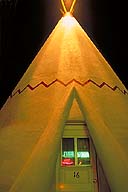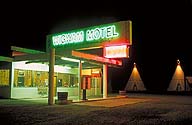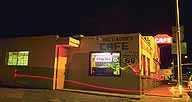Subject:
Such a fine sight to
see... Part I
Date: Mon,
29 Sep 1997 08:48:38 -0700
22:28 McHood
City Park; Winslow, Arizona :: 27 SEP 97
Today was one of those bonus traveler's days. Not much headway,
making just thirty miles or so from our starting point in Holbrook, Arizona.
Instead, it was a meet the locals day, a day full of stories, of sharing
the local lore. And it was a day of learning about small towns and the
dynamos that make them run.

Neon and Kitsch
Holbrook, Arizona


|
The day began typically with us picking up stakes in Holbrook
and moving out by 10:00 AM. Both John and I are eager for western Arizona
where a long segment of old 66 connecting Seligman and Kingman wanders
well off its usual parallel of I-40. We were looking to make some headway,
hoping to at least reach Williams, West of Flagstaff and holder of the
dubious distinction, "last Route 66 town bypassed by Interstate".
With the exception of an adventurous and long dead-end bit of
very old 66 that butts up against the Petrified Forest National Park,
the old highway seems to have been relegated to frontage road for the
Interstate in eastern Arizona. And so far, only the towns of Holbrook
and Winslow have proven interesting enough to risk loitering in. Winslow,
in particular, proved well worth the risk.
Standin' on a corner in Winslow, Arizona.
Name that tune.
The story goes that Jackson Browne wrote the lyric while spending
the night in the Winslow's jail after being picked up for vagrancy. Jackson
was something of a wild one at the time and he'd been whooping it up with
some Hopi friends in town. He'd spent the day in Winslow and the words
for a song had been churning in his head for part of the day already and
the quiet time behind bars gave him an opportunity to work them out. Sometime
later, Glen Frey set the words to music--with Jackson's assistance--so
The Eagles could put it on their debut album. That one song, "Take It
Easy," put Winslow, Arizona on more people's maps across the world than
any other of its noteworthy distinctions.
Carole Lombard spent her last night alive in La Poseda, one
of the so-called Harvey House's built by the Santa Fe railroad to house
and feed its rail passengers on short stopovers. La Poseda itself is an
important landmark as perhaps the best preserved Harvey House in the US.
Charles Lindbergh, who designed Winslow's airport in 1928, often stayed
there, as did John Wayne, Howard Hughes, Errol Flynn and others. The airport
became an important link in the cross-country Air/Rail route of Transcontinental
Air Transportation, later to become Howard Hughes' Trans World Airlines.
08:17 McHood City Park; Winslow, Arizona :: 28 SEP 97
Winslow lived through several overlapping periods: frontier
wagon trail town; major stop on the transcontinental rail line (it remains
Santa Fe Railroad's central office for the Southwest); Route 66 town.
But life here dwindled precipitously when, first the railways added sleepers
and dining service so travellers no longer needed to leave the trains
when they stopped in Winslow for engine and crew changes, and then, October
9, 1979, I-40 bypassed Route 66. "It's like they closed the gate." At
3PM there's endless traffic; at 4PM they open I-40; at 5PM only a trickle
of cars down 66.
"We lost our soul when that happened, and it's taken us nearly
20 years to start getting it back."
23:05 Railside RV Park; Williams, Arizona :: 28 SEP
97
Let me telegraph where I'm going with this one. I've been travelling
Route 66 for nearly a month now looking for...I don't know what. Some
understanding of its magic and what was lost in the transition from open
road to super slab, I guess. Well, I got lucky and found a pearl in Winslow,
Arizona. Finding a pearl when you're not actually sure that's what you're
looking for is no mean feat, something you just don't wish for but had
better acknowledge and exploit if it happens along.
John and I were just passing through town, trying to make Williams
that day. As we came into Winslow one of those brown signs the highways
departments uses for attractions read, "Old Trails Museum." Now, you may
not know this, but many of the National Old Trails, the old wagon trails
like the Osage, Oregon, California and Santa Fe, just to name a few, were
in use well into the 20th century even as automobiles became popular.
These thoroughfares lost their designation as National Old Trails, and
their historic names, when the national highway system--including Route
66--was designated beginning in 1926 in order to accommodate and even
bolster the use of cars and trucks. To cut to the chase, an Old Trails
Museum is right up my alley on this trip. So we pulled in, ate lunch while
waiting for the museum to open and then dove in.
It's a nice little museum, not very different in form from many
of the small town historical museums we've visited on this journey. These
collections are a town's attic and townspeople donate all manner of antiques
and artifacts, filling the museums with items from various periods in
the town.
07:47 Railside RV Park; Williams, Arizona :: 29 SEP
97
I hadn't really thought much about the significance of this
process until Winslow.
John and I spent almost two hours in the Old Trails Museum.
The great thing about small town museums is the availability of its curators
and organisers who add hosting responsibilities to their list of duties.
They and the other volunteers staffing the museum possess an intimate
knowledge of the items on display. The displays provide descriptions but
the museum folk fill out the details with rich stories. Few museums boast
curators or staff with a more intimate knowledge of their collection than
those organised by the historical societies of small towns.
It's great for the visitors but I also learned what this potentially
means for the town, particularly one that feels its soul was ripped out
by a bypass. I'll get to that in another post.
~~~ Responses Sought ~~~
Thanks to the Interstate Highway System, it is now
possible to travel across the country from coast to coast without seeing
anything.
| |
 |
Charles Kuralt
On the Road with Charles Kuralt.
Quote on display in the Old Trails Museum, Winslow, Arizona |